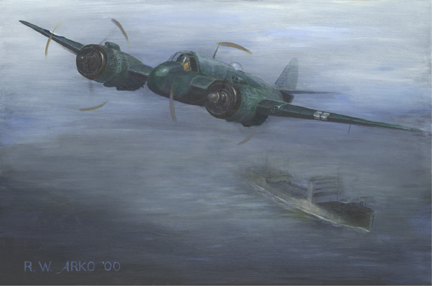Fleming Attacks the Mikuma
by Bob Arko
24" x 36", Acrylic on Canvas
During the Battle of Midway, Marine Bombing Squadron VMSB-241, flying SB2U-3 Vindicator bombers,
attacked the Japanese heavy cruiser HIJMS Mikuma. The marines were led by Capt. Richard E. Fleming, USMCR. Fleming's plane was hit by anti-aircraft fire and caught fire. Fleming was
unable to pull out of his dive and crashed into "X" turret of the cruiser. Flaming AvGas was pulled
into the air intakes of one of the engine rooms, reducing the speed of the ship. Mikuma was sunk on the following day.
Fleming was posthumously awarded the Medal of Honor for his actions, and the South Saint Paul, MN Airport (Fleming Field) is named in his honor.
The Vindicators were at the end of their operational life and weren't structurally sound enough to dive bomb, so Fleming led the squadron in a glide bombing attack. The painting depicts
his attack at the typical 30 degree angle of a glide bombing attack, on the port quarter of the Mikuma, shortly after 8:00 am on June 5, 1942.
On indefinite loan for display at the Fleming Field Administration Building, South St. Paul, MN
White 2
by Bob Arko
12" x 24", Acrylic on Canvasboard
This painting was a study done in preparation for the larger painting "Fleming Attacks the Mikuma".
White 2 refers to the aircraft number painted on the side of the rear fuselage.
An interesting comparison of both paintings shows that the plane in "White 2" is noticably darker
in tonal value than in "Fleming Attacks the Mikuma". This is a result of the tonal value of the backgrounds in each painting.
Both planes are virtually identical in size and layout.
In the collection of Mr. Larry Paul.
B-17
by Bob Arko
24" x 36", Acrylic on Canvas
This is a "generic" B-17 (no specific squadron or historical incident),
inspired by a much more complicated work by Robert Taylor. My focus here
was to develop the light and shadow on the curves and angles of the plane
to heighten the 3-D illusion of flight.
Beaufighter
by Bob Arko
24" x 36", Acrylic on Canvas
The Royal Australian Air Force used the Bristol Beaufighter in a naval
interdiction role, attacking transports and light naval vessels. Here a
Beaufighter TFX makes a pass at a Seishin Maru class merchant ship.
Bf-110
by Bob Arko
24" x 36", Acrylic on Canvas
Although the most famous group sporting the "Shark's Teeth" motif as a unit marking
may be the Flying Tigers (the American Volunteer Group in China) in 1942, They were
not the first to use that idea. The Luftwaffe's JG-72 adopted
the "Shark's Teeth" motif as their squadron emblem in 1940. Here a
Bf-110c of JG-72 patrols along the British coast at the beginning of the Battle of Britain.
Bombing 5
by Bob Arko
16" x 20", Acrylic on Canvas
The Curtiss BF2C-1 was only used by Squadron VB-5B (Bombing 5) of the USS Ranger
between November, 1934 and February, 1936. While the new metal-frame wings of this design had
performed well on prototype aircraft, the natural period of vibration of the metal wings
harmonized with that of the Wright Cyclone engine of the production model, and the
airplane nearly shook apart at cruising speed. As a result, they were withdrawn from the
fleet after barely a year in service. Interestingly, the export version of this model, the Hawk III,
used wooden wings and did not have a vibration problem.
TBF
by Bob Arko
28" x 42", Acrylic on Canvas
The first six TBF-1's to see combat were assigned to VT-8 of USS Hornet, but operated
from Midway Island for the Battle of Midway in June 1942. Of the six Avengers
that attacked the Japanese, only one, 8-T-1, survived.
EA6B
by Bob Arko
16" x 20", Acrylic on Canvas
The EA-6B provided electronic countermeasures for their carrier air group.
Here a Prowler of VAQ-133, "The Wizards", is seen with its home carrier USS
America, CV-66, in the background during the Viet Nam War.
In the collection of Mr. William Ross.
Copyright Robert W. Arko 2006







